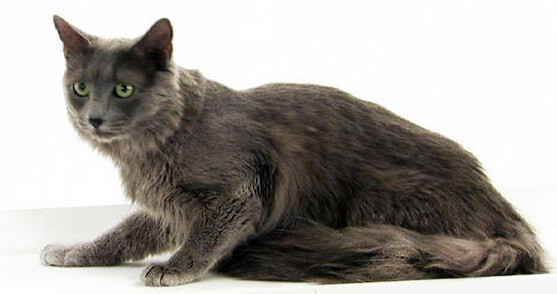Type the name of the breed you're looking for below
[wpdreams_ajaxsearchlite] Don't see the breed your're looking for? Click here and let us know!
Breed Characteristics
1 paw - breed exhibits the least amount of this characteristic
5 paws - breed exhibits most amount of this characteristic
Nebelung
| Origin And History | The Nebelung breed began the way so many of our breeds began, a stray cat wandered out of the mist and into someone's home and heart. In the early 1980s a black domestic vagabond-turned-housecat named Terri produced a litter of three- two shorthaired black females and one longhaired male. The father, another anonymous nomad, was thought to have been an Angora mix. Terri's owner, Cora Cobb of Denver, Colorado, gave one of the female kittens, Elsa, to her son, and in 1984 this shorthaired black domestic produced a litter of kittens that included a blue semi-longhaired male kitten. Subsequently named Siegfried, this kitten became the Nebelung's foundation cat. Elsa's next litter, fathered by the same shorthaired Russian Blue-type neighborhood Tom, produced a female kitten, Brunhilde, who possessed Siegfried's qualities and characteristics. By that time, Cobb was so taken with Siegfried's beauty and personality that she decided to see if she could preserve his qualities by breeding brother to sister. In May 1986 Siegfried and Brunhilde proved to Cobb that they bred true by producing a litter of three blue longhaired kittens. Cobb named the cat the Nebelung, a German word that means 'creatures of the mist'. On the advice of TICA's genetics chairperson Dr. Solveig Pflueger, to whom Cobb turned for guidance in establishing her new breed, Cobb wrote the Nebelung's standard to match the Russian Blue's, almost word for word except for the coat length and the general opening description. TICA accepted the Nebelung for registration in September 1987. At first, the Russian Blue breeders were cautious about accepting Cobb's newcomers and Cobb had difficulty finding a breeder who would provide registered Russian Blue breeding stock. Finally, the owner of Supreme Grand Champion Vladimir of Castlecats agreed to offer her cat for stud with one of Brunhilde's daughters, who produced a litter in June 1988. Since then, the number of Nebelungs has slowly grown and, despite setbacks, the breed has caught worldwide attention. The Nebelung has appeared twice on the front cover of a Japanese cat magazine, and Nebelungs were shown and sold at the 1989 TICA cat show in Paris, France. Only a handful of breeders are currently working with the Nebelung, but breeders are expecting that number to grow and hope to achieve recognition with CFA within the next few years. |
| Personality | Nebelung Cat breeds adapt immediately to their new environment. They have no physical or emotional when moving into a new home! This cat breed will take the time to meet new people. Owners should expect it to join in the company whenever they have a visitor. The Nebelung Cat really enjoys interacting with its owners. Owners of this cat should expect to spend time with it almost daily! This cat can get along well with children who are kind towards it, but it does not do well with children who are handling it poorly. Owners should not expect any problem when introducing their Nebelung Cat into a living space with dogs. They often look forward to playing with their canine housemates! The Nebelung Cat breed can be loving on occasion. Some owners say that their Nebelung Cat will be affectionate one moment, and act like a stranger the next. The Nebelung Cat breed is quite playful. Owners should have a stash of fun cat toys available for this cat breed! Energy is not a problem for the Nebelung Cat. At times it can appear to have an endless amount! Owners have been successful in training this cat because the Nebelung Cat is a very intelligent breed. |
Physical Attributes
| Appearance | When it comes to the Nebelung, the operative word is long: long, graceful neck and body, long legs, long coat, and long tail. Slightly oval eyes are a vivid green colour, or sometimes a yellow-green. Large, pointed ears sit atop a modified wedge-shaped head that is more pointed than rounded. The overall appearance is of a long, sturdy, well-muscled cat. The soft double coat feels fine and silky; it is a beautiful gray color and is tipped with silver. Males and, to a lesser extent, females have a ruff around the neck. The fur on the tail is longer than that on the body. Tufts of fur are found behind the ears and in-between the toes, and the hind legs sport pantaloons. |
| Health | The adult coat reaches its full development when the cat is approximately two years old. Life span of a Nebelung is 16+ years. A Nebelung weighs between 3.5 kg (7.11 lbs) for female and 6.5 kg (14.5 lbs) for male sterilized. This is a cat breed that does not have health issues very often. Health issues are common among domesticated animals. This cat breed may be susceptible to Diarrhea, Tapeworms, and Fleas. The Nebelung Cat breed may cause a reaction in those who have cat allergies. |



